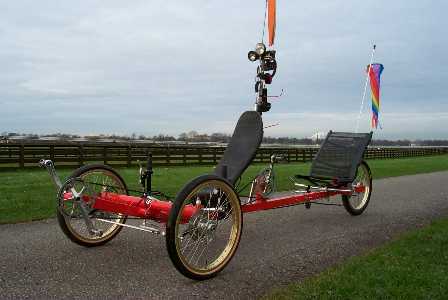
As yet unnamed...my friend David West suggests PELT (Pete's Extremely
Long Tandem)...

This machine was built to my own design, and I machined all the special bits on a Myford ML7 lathe...the seats came from my S-327 trike and an Ostrad recumbent. Welding and powdercoating by Jemison Engineering of Bishopthorpe, York (tel 01904 703863), help, advice and most of the components from Mike West of Bishopthorpe Bikes (Tel 01904 703 413 afternoons).
 Outside Bishopthorpe Bikes
Outside Bishopthorpe Bikes
The frame is mild steel seamed tubing from a scrap merchant (Clancy's, Murton nr York) - mostly 2" x 1/16, some 50mm x 2mm, and cost me not a lot (something like 20p a kilo). Alloy parts were mostly machined from scrap bought at the Rufforth Autojumble (1st Saturday of the month, just East of Rufforth), where I also buy machine tools and other oddments.
Further credits to Ian Sims of Greenspeed for the original inspiration, and for speedy and efficient service in sending kingpins, hubs and chain pulleys. Rob Hague of Westcountry Recumbents for tyres, Wyko Bearings of York for bearings and rod-ends, Martyn and all at York Cycleworks for the Hope Disk brakes and other bits, and not least, my housemate Arthur Clune for putting up with me machining the beast in my bedroom, and assembling it in the living room.

Sorry for the very lossy compression on these 'index' photos. I'll try to re-do them sometime...
p0000032 and p0000033 (click
these links for 1792 x 1200 JPGs, about 330k each) show the overall layout.
The rear seat can be moved forwards all the way up to the rear crankset,
or back to suit someone just about 6' tall (it's just too short for me,
at 6'2"). There's foot clearance for size 47 feet even with the front seat
moved right back. Both seats are clamped to the square-section frame, using
custom-machined mountings. To move them, just undo the bolts and slide
- then adjust the angle of the rear seat. No chain adjustments are needed...
The complete machine weighs about 40kg, going by some bathroom scales
I borrowed. Not too bad, considering the commerical equivalents go to about
30kg, and I've added suspension, independent freewheels and a separation
system considerably heavier than S&S couplings.
The machine separates for transport/storage just behind the front seat,
just in front of the rear seat, and the front 'cross-beam' comes off. With
kingpins and seat removed, too, it goes very small, a long thin package.
But it takes a while to do - not a problem, if you're travelling by train
to the start of a long tour.
p0000035 (click for 1792 x 1200 JPG, about 330k) shows the rear suspension. The suspension element was made using an old exhaust bushing, so giving rubber in shear. But this turned out a bit 'soft', so I stuck in a piece of rubber on top of it - it works nicely. The suspension pivots on nylon bushings. You can also see the rear drum brake (not strictly necessary with twin Hopes on the front, but I had the hub so thought I might as well use it...) and the seat angle adjustment. I have some longer bits of alloy for when the seat is right forward. Also visible is the 'kink' in the drive chain and the two pulleys...not intentional really, and I should be able to get away with one, or maybe zero, pulleys if I get round to making a 'Mark II'..
p0000036 (click for 1792 x 1200 JPG, about
330k) shows the intermediate driveshaft. I used the 'da Vinci' system (see
here for the da Vinci website) which has each person driving a freewheel,
and cassette sprockets acting as 'chainrings'. It gives independent freewheeling
for both rider, and a wide range of gears. Alhough da Vinci do sell the
parts required, I made my own: a double freewheel boss, and a splined support
for the sprockets (which took ages to machine!). Both run on a 16mm shaft,
turned down to 5/8" because no-one supplies 16mm bearings...
Incidentally, this system gives a very 'clean' stoker area, with the
chain to the freewheel running forwards, and the transmission chain way
down low. This should make it even easier to persuade stokers to have a
go.
Also incidentally, the extra length of thread protruding below the
front seat mounting block clamps is intentional - it allows me to attach
the seat to the S-327 recumbent easily - it has a rather deeper square-section
main beam.
(click here for Page 2)
(click here for Page 3)
(Back to Pete)